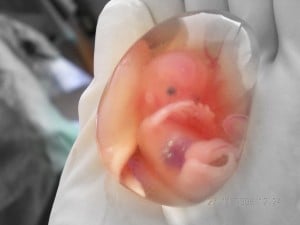Yesterday Dr. John Willke, known worldwide as the Father of the Pro-Life Movement, passed away unexpectedly at his home at the age of 89.
* * * * *
I was in college in about 1970, when I first learned of the pro-life work of Dr. John Willke. One winter’s evening, a spokesperson for Dr. Willke’s recently founded organization Right To Life was invited to address my undergrad sociology class. He brought with him a slide show which explained several ways that pregnancies could be ended by abortions.
Think how different the times were: The Supreme Court had not yet issued its deadly Roe v. Wade decision, legalizing the killing of the unborn in every state in America. In 1970, at least among my circle of friends, abortion was rarely discussed and we all had little information about what the procedure actually entailed. The only way to get an abortion–at least in my part of the country–was to travel to New York, where a pregnancy could be deliberately ended without fear of criminal penalties.
But the winds of change were blowing, and feminists such as Gloria Steinem and Bella Abzug were demanding greater access to abortion in every state.
Enter a Cincinnati-based physician, Dr. John Willke, and his wife Barbara. The Willkies began speaking about abortion, traveling around the country to explain the ghastly procedure. When they could no longer keep up with the demand for their pro-life talks, they began to write books and to develop the slide presentation that I saw.
Here was my reaction: I was young and still single. I didn’t know much about babies or about abortion, but as I looked at the fetal remains–arms and legs, burned torsos, swollen heads–I understood that I couldn’t do that to a rabbit. I became pro-life by watching those slides.
Years later, I sat in Dr. Willkie’s office at National Right To Life in Washington D.C. and told him that story. He got tears in his eyes as he revealed that he was, in fact, the author of those slides.
* * * * *
I met the Willkies a few times in the years that followed–and of course, I read their books. Once, during my years as conference director for Legatus, I met them during the organization’s international conference in Florida. Always humble, the Willkies preferred to stay, not at the first-class hotel where the rest of the members were housed, but down the road at a less-expensive hotel with the conference organizers. They regaled us with stories at breakfast on the terrace, then rode with me in a trolley to the conference venue.
* * * * *
In case you haven’t heard, these are the methods of abortion which were explained and illustrated on those slides so many years ago:
Suction aspiration, the simplest form used in the first six to 12 weeks of pregnancy The Pro-Life Action League explains the procedure:
Suction aspiration, the most common abortion method, is typically performed when the fetus is 6-12 weeks, but can be used up to 16 weeks. The cervix is dilated, and a hollow plastic tube with a sharp tip is inserted into the cervix and then into the uterus. An aspirator attached to the tube tears the body of the fetus apart and suctions the pieces through the tube.
D & C (dilation and curettage), used in the sixth through 12th weeks of pregnancy.
A suction/D & C abortion is performed when the fetus is 6-12 weeks. The cervix is opened using an osmotic dilator. Then a curette (a thin metal rod with a knife-sharp loop at the end) is inserted into the uterus. The curette is used to dismember the fetus.
After this, a cannula (a hollow plastic tube) attached to a suction aspirator is inserted to remove the fetus, placenta and uterine lining. These are captured by a stockinet attached to the end of the suction tube.
A D & E (dilation and evacuation) abortion is performed in the second trimester (12-24 weeks).
D & E and is usually a 2-3 day procedure. At this stage of pregnancy, the fetus’ tendons, muscles, and bones are more developed. The cervix has closed more tightly and must be dilated enough to remove the larger fetus.
To aid in cervical dilation, laminaria (dried seaweed sticks) are inserted into the cervix. The dilation process can take 1-2 days depending on the size of the fetus.
Once the cervix is sufficiently dilated, the laminaria are removed. Forceps are inserted into the uterus to forcibly dismember the fetus. The skull is then crushed and removed. A suction aspiration is then introduced to remove any remaining fetal parts, the placenta and uterine lining.
D & X (dilation and extraction, or partial birth abortion) is offered after 24 weeks, when the fetus is too large to be removed via any of the simpler procedures. Pro-Life Action League describes that procedure:
As with the D & E, the cervix must be dilated using laminaria.
Forceps are then introduced into the uterus to grasp the baby’s legs. The baby is delivered breech while the head remains inside the birth canal. Using blunt-tipped surgical scissors, the base of the skull is pierced and a suction catheter is inserted to extract the brain. This causes the skull to collapse and the dead baby is then fully delivered.
Those were the forms of abortion commonly available in 1973. A chemical abortion (RU-486) was developed later, and involves at least three visits to the doctor’s office or clinic.
At the first visit, the woman is given a physical exam and is administered mifepristone. RU-486 blocks the action of progesterone, the natural hormone vital to maintaining the lining of the uterus. The embryo starves as the nutrient lining disintegrates.
At a second visit, 36-48 hours later, the woman is giving a dose of artificial prostaglandins, usually misoprostol, which initiate uterine contractions and usually cause the embryo to be expelled from the uterus. Most women abort during the four hour waiting period, but about 30% abort as many as five days later—at home, work, etc.
A third visit about 2 weeks later determines whether the abortion has occurred or if a surgical abortion is necessary to complete the procedure.
* * * * *
This week, the world has lost a great spokesperson for the babies, the children abandoned in their mothers’ wombs. Brad Mattes of Life Issues Institute, a long-time friend of Dr. Willke, announced:
“We are deeply saddened to report that Dr. Jack Willke, president of Life Issues Institute, passed away unexpectedly at his home on Friday, February 20. Dr. Willke and his wife Barbara, who proceeded him in death, were considered the parents of the pro-life movement. Their educational materials have been responsible for educating millions on abortion and were translated into 32 languages.
“Words can’t possibly express how sad we feel. Jack was almost 90 and we new the time was approaching when he’d join his dear Barbara in heaven, but it’s hard to say goodbye. Jack has been my mentor and colleague for over 23 years and was a second father to me.”
Mattes added,
“I can only imagine the greeting Jack received in heaven. Millions of babies whom he tirelessly worked to saved, joyfully welcoming him home.”
What a joy it must be to stand at the throne of Christ and to hear the words, “Well done, good and loyal servant.”
I am grateful to Dr. Willkie for his tireless service. Because of him, hearts have been changed, lives have been saved, and the world has become a better place. There is still work to be done–but continue we must, following in his noble footsteps.
* * * * *
In November 2014, Dr. Willkie offered a Thanksgiving message. In this brief video, he responds to the question, “Will we get a pro-life president?”












